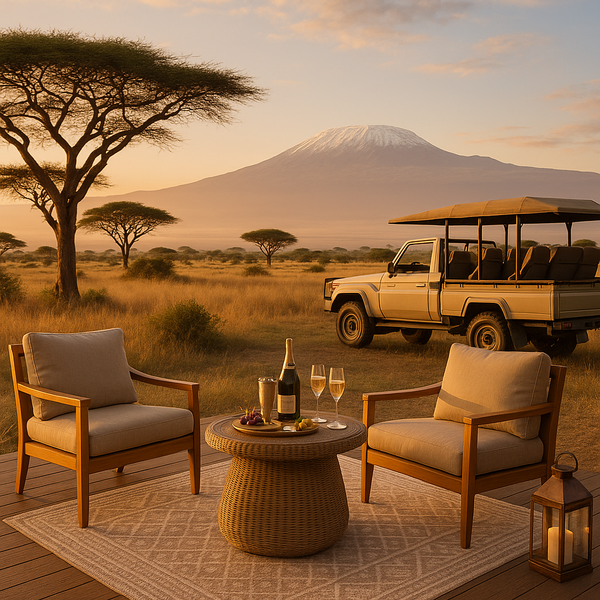
Embark on an unparalleled adventure across the iconic landscapes of East Africa. A 14-day safari through Kenya and Tanzania offers an immersive journey into the heart of the continent's most celebrated wildlife reserves. Prepare for breathtaking encounters, luxurious accommodations, and unforgettable moments that redefine the safari experience.
Unveiling Kenya's Wonders: From Savannah to Migration
Your East African odyssey often begins amidst the rolling plains and acacia-dotted savannahs of Kenya, a country synonymous with classic safari adventures. The Maasai Mara National Reserve is a cornerstone of any Kenyan safari, particularly renowned for hosting the Great Migration during certain times of the year – a spectacle involving millions of wildebeest, zebras, and gazelles traversing the Mara River, often braving crocodile-infested waters. Beyond the migration, the Mara offers year-round exceptional game viewing, boasting a high density of predators, including lions, cheetahs, and leopards. Luxury lodges and tented camps within or bordering the reserve provide unparalleled access to the wildlife action while offering sophisticated comfort, gourmet dining, and personalized service. Imagine watching elephants graze from your private deck or enjoying a sundowner overlooking the vast plains after a thrilling game drive. A 14-day itinerary allows ample time to explore different sectors of the Mara or even combine it with other diverse Kenyan parks. Consider the conservancies bordering the main reserve, which often offer more exclusive game viewing opportunities, walking safaris, and night drives not permitted in the national reserve itself. Other Kenyan destinations like Amboseli National Park, famous for its large elephant herds set against the stunning backdrop of Mount Kilimanjaro, or Laikipia Plateau, known for its conservation efforts and diverse wildlife including rare species, can be woven into the itinerary, adding layers to the rich tapestry of the Kenyan wilderness experience. Each region offers a unique ecosystem and wildlife viewing perspective, ensuring that the Kenyan portion of your safari is both diverse and deeply engaging, setting the stage for the Tanzanian leg of the journey.
Exploring Tanzania's Iconic Landscapes: Serengeti to Crater
Crossing into Tanzania brings you face-to-face with equally legendary destinations, each offering a distinct natural wonder. The Serengeti National Park, a name that resonates globally with wildlife enthusiasts, is arguably the most famous safari destination on Earth. This vast ecosystem is an extension of the Maasai Mara and is also central to the Great Migration cycle as herds move towards greener pastures. The sheer scale of the Serengeti is awe-inspiring, offering endless horizons teeming with wildlife. Game drives here are characterized by encounters with large prides of lions, solitary leopards, cheetahs, and massive herds of ungulates. Luxury camps in the Serengeti are often mobile or strategically located to follow the migration, providing guests with front-row seats to nature's grandest spectacle. These camps offer a blend of traditional safari charm and modern luxury, with spacious tents, comfortable furnishings, and attentive staff. Another jewel in Tanzania's crown is the Ngorongoro Conservation Area, home to the breathtaking Ngorongoro Crater – a UNESCO World Heritage site and the world's largest intact volcanic caldera. Descending into the crater floor is like entering a lost world, a self-contained ecosystem supporting an incredible density of wildlife, including the endangered black rhino. The unique environment of the crater allows for exceptional, close-range wildlife viewing. High-end lodges perched on the crater rim offer stunning panoramic views, adding a dramatic element to the stay. Combining the vastness of the Serengeti with the concentrated wildlife of the Ngorongoro Crater provides a comprehensive and diverse Tanzanian safari experience, showcasing the best of what this incredible country has to offer within a single, unforgettable journey that complements the Kenyan leg perfectly.
The Essence of a Five-Star Safari Experience
A true five-star safari transcends mere game viewing; it is an immersion in luxury, comfort, and unparalleled service. This level of experience means staying in properties that offer not just accommodation, but an extension of the wilderness adventure, albeit in supreme comfort. Think lavish tented suites with king-sized beds, en-suite bathrooms with hot showers, and private verandahs overlooking the plains. Lodges often feature infinity pools with views of watering holes, gourmet dining experiences under the stars, and well-appointed lounges perfect for unwinding after a day of exploration. Expert guides are fundamental to the luxury safari. These knowledgeable professionals are not just drivers; they are skilled trackers, naturalists, and storytellers who enhance every game drive with insightful commentary on animal behavior, local ecology, and cultural nuances. They understand the subtle signs of the bush and work tirelessly to provide exceptional wildlife encounters while respecting the animals and their environment. Personalized service is paramount, from seamless airport transfers and internal flights to thoughtful touches like having your favorite drink ready upon your return or a hot water bottle placed in your bed on a cool evening. Exclusive activities, such as hot air balloon safaris over the Serengeti at dawn, guided walking safaris, cultural visits to Maasai villages (conducted respectfully and ethically), or private sundowners in remote locations, elevate the experience. The logistics of a multi-country, multi-location safari are expertly handled, often involving light aircraft flights between parks, minimizing travel time and maximizing time spent experiencing the wildlife and landscapes. This attention to detail and commitment to excellence ensures that every moment of your 14-day journey is effortless, enriching, and truly unforgettable.
Planning Your Ultimate East African Journey
Undertaking a 14-day luxury safari in Kenya and Tanzania requires careful planning to ensure a seamless and fulfilling experience. One of the first considerations is the timing of your visit, particularly if witnessing the Great Migration is a priority, as its location varies throughout the year. Generally, the dry seasons (June to October and December to March) are excellent for game viewing as vegetation is sparse and animals congregate around water sources. However, the 'green season' (November, April, May) offers lush landscapes, fewer crowds, and migratory bird species, though game viewing can be slightly more challenging. Choosing the right safari operator is crucial for a luxury experience; look for those with strong reputations, experienced guides, and access to premium lodges and camps. They can tailor an itinerary to your specific interests, whether you prioritize photography, birdwatching, or seeking specific wildlife encounters. Packing for a safari involves practical considerations: lightweight, neutral-colored clothing suitable for warm days and cool evenings, layers, comfortable walking shoes, a wide-brimmed hat, sunscreen, insect repellent, and essential items like binoculars and a good camera with a telephoto lens. Luxury lodges often provide amenities like toiletries, but check in advance. Health preparations, including vaccinations and anti-malarial medication, are essential and should be discussed with a travel health professional well before departure. Internal travel between parks and countries is typically by light aircraft, offering breathtaking aerial views but also imposing strict luggage weight limits – usually around 15-20 kg per person in soft-sided bags. Understanding these limitations is key to efficient packing. While this is a luxury trip, respectful cultural interaction is important when visiting local communities; your guide can provide guidance on appropriate behavior and photography etiquette. Preparing adequately ensures you can fully relax and immerse yourself in the magic of the East African bush.
Beyond Wildlife: Culture and Conservation
While the primary focus of a Kenya and Tanzania safari is undoubtedly the incredible wildlife, the journey also offers rich opportunities to engage with the vibrant cultures and understand the critical conservation efforts underway. Both countries are home to diverse ethnic groups, with the Maasai being one of the most well-known, inhabiting areas around the major parks. Many luxury safari itineraries include options for respectful cultural visits to Maasai villages, providing a glimpse into their traditional way of life, customs, and dances. These interactions, when facilitated by reputable operators who ensure the community benefits directly, offer valuable cultural insights. Beyond the Maasai, Tanzania is home to over 120 different ethnic groups, each with its own unique heritage, contributing to a rich cultural mosaic. Understanding the local communities' relationship with the land and wildlife adds another dimension to the safari experience. Furthermore, luxury safari operators often play a significant role in conservation. Many lodges and camps operate on private conservancies that work closely with local communities to protect wildlife corridors and habitats. By choosing to stay in these properties, visitors directly contribute to conservation funding and community development initiatives. Learning about these efforts, whether through discussions with guides, visiting community projects, or seeing anti-poaching units in action (where appropriate), highlights the delicate balance between tourism, conservation, and the livelihoods of local people. A luxury safari can therefore be not just a passive observation of nature but an active engagement with the forces shaping the future of these precious ecosystems and the people who share them. This deeper understanding makes the 14-day journey not just a vacation, but a meaningful experience that connects you to the heart of East Africa.

